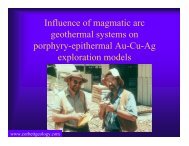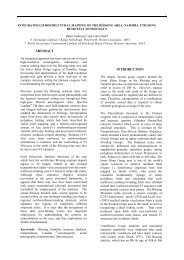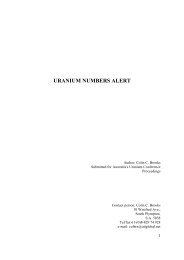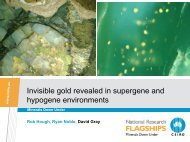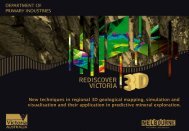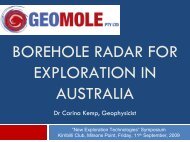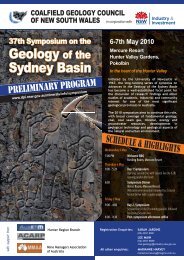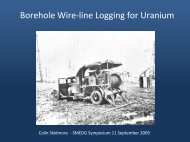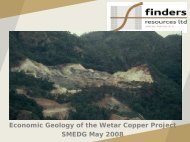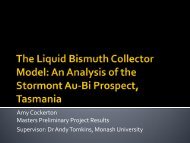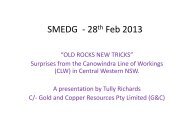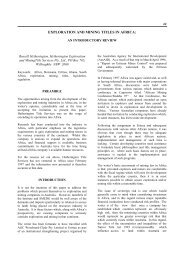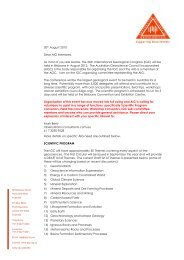Regolith-Landforms and regolith geochemistry of the 'Tomahawk' Au ...
Regolith-Landforms and regolith geochemistry of the 'Tomahawk' Au ...
Regolith-Landforms and regolith geochemistry of the 'Tomahawk' Au ...
You also want an ePaper? Increase the reach of your titles
YUMPU automatically turns print PDFs into web optimized ePapers that Google loves.
<strong>Regolith</strong>-<strong>L<strong>and</strong>forms</strong> <strong>and</strong> <strong>regolith</strong><br />
<strong>geochemistry</strong> <strong>of</strong> <strong>the</strong><br />
‘Tomahawk’ <strong>Au</strong>-in-calcrete anomaly:<br />
Tunkillia, Gawler Craton, South <strong>Au</strong>stralia.<br />
SMEDG/AIG Honours Bursary<br />
Laura Klingberg<br />
25 th February 2010<br />
Supervisor: Steve Hill 1
The Challenge:<br />
1. Aeolian Dunefields <strong>geochemistry</strong> is exotic to underlying substrate targeted in<br />
surficial mineral exploration<br />
2. Calcrete exploration “Feeding Frenzy”<br />
� Not underst<strong>and</strong>ing <strong>the</strong> chemistry behind<br />
� Not always sampling true calcrete<br />
3. Pedogenic carbonates cover ~21% <strong>Au</strong>stralia’s l<strong>and</strong> surface<br />
�Economically important deposits:<br />
�Challenger<br />
�>10 ppb Tunkillia <strong>Au</strong>-in-calcrete anomaly<br />
The distribution <strong>of</strong> calcrete (red)<br />
<strong>and</strong> associated soils in <strong>Au</strong>stralia<br />
(Lintern 1997).<br />
2
The Challenge:<br />
‘False anomalies’<br />
� high <strong>Au</strong> content in carbonates<br />
� NO underlying source <strong>of</strong> mineralisation<br />
� At Tomahawk <strong>Au</strong>-in-calcrete anomaly:<br />
Previous exploration drilling programs, have failed to identify significant<br />
underlying mineralisation<br />
This is an ideal setting to try <strong>and</strong> better constrain linkages<br />
between <strong>Au</strong>-in-calcrete <strong>and</strong> adjacent mineralisation sources<br />
3
Findings<br />
1. Palaeo- <strong>and</strong> contemporary l<strong>and</strong>scape setting is CRUCIAL!<br />
2. Multi-element calcrete analyses “optimises” this particular<br />
sampling technique<br />
3. This ‘Tomahawk’ study INTEGRATES l<strong>and</strong>scape setting <strong>and</strong> multielement<br />
calcrete <strong>geochemistry</strong> to show a large component <strong>of</strong> <strong>the</strong><br />
‘Tomahawk’ <strong>Au</strong>-in-calcrete anomaly is transported<br />
4
Tunkillia tenement Location & L<strong>and</strong> use<br />
� ~660 km northwest <strong>of</strong> Adelaide, ~70 km south-sou<strong>the</strong>ast <strong>of</strong> Tarcoola<br />
� Moderate access, 4WD vehicles essential<br />
� Covered by well vegetated Pleistocene s<strong>and</strong> dunes<br />
(Lowrey 2007)
Tunkillia Geological Setting<br />
PALAEOPROTEROZOIC<br />
~1730-1690 ma Yarlbrinda Shear Zone formation �Kimban Orogeny<br />
~1690-1670 ma Host rocks: Tunkillia Suite granitoids intruded <strong>the</strong> crust<br />
MESOPROTEROZOIC<br />
�Kararan Orogeny<br />
~1590-1575 ma Reactivation <strong>of</strong> <strong>the</strong> Yarlbrinda Shear Zone<br />
Shearing <strong>and</strong> brecciating host rocks<br />
Mineralisation <strong>and</strong> demagnetisation is syn-deformational to main shearing event:<br />
Most likely associated with a fluid influx from <strong>the</strong> syn-tectonic emplacement <strong>of</strong><br />
Hiltaba Suite granites (~1590-1575 Ma) within <strong>the</strong> active YSZ<br />
Fluids derived from granite mixed with low salinity metamorphic fluids 6<br />
at<br />
depth, <strong>and</strong> trapped at sites <strong>of</strong> fault intersections within <strong>the</strong> shear zone
Tunkillia known Mineralisation<br />
� Gold is associated with pyrite <strong>and</strong><br />
minor galena<br />
� Hosted in striking 325 o /steep west<br />
dipping quartz-sulphide veins<br />
� Within chlorite-sericite alteration<br />
(Martin & Wilson 2005)<br />
(Ferris & Wilson 2004)<br />
� YSZ: Gravity LOW<br />
� Eastern Demagnetised zone<br />
� Western Demagnetised zone<br />
Structure appears to be <strong>the</strong><br />
dominant control on<br />
mineralisation<br />
7
‘Tomahawk’ <strong>Regolith</strong>-L<strong>and</strong>form Map: Outcome<br />
� Interpret<br />
surficial<br />
transport<br />
pathways<br />
� Constrain<br />
dispersion/<br />
deposition<br />
occurring<br />
� To be used<br />
later to plot<br />
calcrete assay<br />
results spatially<br />
1:10,000 scale<br />
8
Dunefields<br />
Alluvial<br />
Drainage<br />
Erosional<br />
Plains<br />
Depositional<br />
Plains<br />
Saprolith<br />
9
<strong>Regolith</strong> Pr<strong>of</strong>iles<br />
� 11 detailed <strong>regolith</strong> pr<strong>of</strong>iles were logged along ‘Tomahawk’ anomaly<br />
transects to establish:<br />
� Typical wea<strong>the</strong>ring pr<strong>of</strong>ile <strong>of</strong> ‘Tomahawk’ / Tunkillia<br />
� If wea<strong>the</strong>ring pr<strong>of</strong>ile vary with depth <strong>and</strong> composition, <strong>and</strong> between<br />
aeolian dunes vs. palaeo/contemporary drainage<br />
10
Did previous drilling achieve <strong>the</strong>ir target <strong>of</strong><br />
reaching fresh basement?<br />
� Drilling in some l<strong>and</strong>form types finished short <strong>of</strong> fresh bedrock.<br />
� Ceased in saprock OR saprolite (<strong>Au</strong>-depleted zone above<br />
mineralisation)<br />
Suggesting possibly that previous RAB drilling conducted in<br />
this area may not have sufficiently tested <strong>the</strong> anomaly.<br />
Of <strong>the</strong> total 11 holes logged, 7 did not reach basement.<br />
HOWEVER: Over time rock chips are subject to disintegration /<br />
degradation via wea<strong>the</strong>ring <strong>and</strong> climate controls, several metres<br />
may be missing due to wind or water erosion at surface<br />
11
Previous Exploration:<br />
1. Largely based on <strong>Au</strong>-only geochemical results.<br />
� Limited consideration <strong>of</strong> multi-element expressions <strong>of</strong> mineralisation using:<br />
� Accessory <strong>and</strong> pathfinder elements<br />
� Major / secondary mineral host elements<br />
Total <strong>of</strong> 98 RC’s collected from surface on opportunistic basis<br />
� prepared <strong>and</strong> sent to Genalysis Lab Services, Adelaide<br />
2. The only study at ‘Tomahawk’ to analyse full geochemical multi-element suite<br />
12
12 Elements <strong>of</strong> Interest: Importance <strong>of</strong><br />
multi-element analyses<br />
� Associated with mineralisation <strong>and</strong> known indicator<br />
elements (<strong>Au</strong>, Ag, Pb, Zn, Sb <strong>and</strong> La);<br />
� Secondary trace element host minerals<br />
(Ca, Fe <strong>and</strong> Al);<br />
� Traditional pathfinder elements for <strong>Au</strong> from previous<br />
studies (As); <strong>and</strong>,<br />
� O<strong>the</strong>r commodities that could be prospective in <strong>the</strong> area<br />
(Cu <strong>and</strong> U).<br />
13
Sub-populations for data analysis<br />
14
Gold (<strong>Au</strong>)<br />
� Highest <strong>Au</strong> in ISps 2 unit<br />
surrounded by CHep<br />
� Lower margins <strong>of</strong><br />
topography<br />
� Recently formed<br />
l<strong>and</strong>forms revealing<br />
remnant underlying<br />
l<strong>and</strong>form<br />
� Palaeodrainage System<br />
� <strong>Au</strong> mobilised/redeposited<br />
in <strong>the</strong> secondary<br />
environment<br />
15
Silver (Ag)<br />
� Majority below<br />
analytical DL<br />
� High <strong>Au</strong> <strong>and</strong> Ag CHep1<br />
� Flanking to <strong>the</strong> SW:<br />
� Alteration halo<br />
associated/<br />
surrounding <strong>Au</strong><br />
mineralisation?<br />
� Low Ag in calcrete<br />
samples is consistent<br />
with preferential<br />
leaching <strong>of</strong> Ag from<br />
primary mineralisation.<br />
Ag has most likely been mobilised fur<strong>the</strong>r north<br />
via palaeodrainage channels. 16
� Small exposures<br />
<strong>of</strong> wea<strong>the</strong>red in<br />
situ quartz vein<br />
detected:<br />
� Could be a<br />
source for <strong>the</strong><br />
high <strong>Au</strong> <strong>and</strong> Ag<br />
values detected<br />
downslope<br />
17
Aluminium (Al)<br />
� Al in <strong>the</strong> secondary<br />
environment can be<br />
physically mobilised<br />
as Al-oxides (clay<br />
minerals)<br />
Central region concentrations occur from wea<strong>the</strong>ring <strong>of</strong> parent<br />
materials <strong>and</strong> subsequent movement <strong>of</strong> clay minerals via<br />
palaeochannels<br />
18
Lead, Zinc <strong>and</strong> Iron<br />
� Elements associated with mineralisation:<br />
� Pb (galena PbS),<br />
� Zn (sphalerite (Zn,Fe)S)<br />
� Fe (pyrite Fe 2S)<br />
� Poor relationships with <strong>the</strong> mineralised areas, however<br />
individual highs coincide with each o<strong>the</strong>r.<br />
19
Pb<br />
Fe<br />
Zn<br />
� Fe-oxide hosted halo to <strong>the</strong><br />
NE <strong>of</strong> a possible mineralisation<br />
source<br />
� Pb is less mobile (more<br />
proximal to a sulphide source)<br />
� Zn is more mobile (occurs<br />
fur<strong>the</strong>r from source)<br />
� All immobile<br />
20
Importance <strong>of</strong> Palaeol<strong>and</strong>scape:<br />
The Sou<strong>the</strong>rn Drainage Divide<br />
� Dart, 2009<br />
� Known bedrockhosted<br />
mineralisation at<br />
Tunkillia occurs on<br />
<strong>the</strong> N side <strong>of</strong> a<br />
regional drainage<br />
divide.<br />
� Elevation change<br />
~220m to 190m.<br />
21
Continued:<br />
Derivative Map<br />
� Dart (2009) produced a<br />
symbolic overview <strong>of</strong> <strong>the</strong><br />
drainage pathways at<br />
Tunkillia<br />
� ‘Tunkillia Central’<br />
palaeodrainage extended<br />
across ‘Area 223’ <strong>and</strong><br />
followed <strong>the</strong> <strong>Au</strong>-incalcrete<br />
anomaly.<br />
22<br />
(Dart 2009)
“Tomahawk”<br />
Building on Drainage<br />
Map from Dart (2009):<br />
Detail added in this<br />
study:<br />
24
� ‘Tomahawk’ is associated<br />
with a low lying area<br />
� A point <strong>of</strong> low, broad<br />
mixing <strong>and</strong> confluence <strong>of</strong><br />
several palaeodrainage<br />
channels<br />
� Origin: sou<strong>the</strong>rn drainage<br />
divide<br />
� Provenance: northwards<br />
� Dart (2009), suggested<br />
that ‘Tomahawk’, sou<strong>the</strong>ast<br />
<strong>of</strong> ‘Area 191’, is potentially<br />
up-palaeo slope<br />
25
In Summary:<br />
1. Palaeo- <strong>and</strong> contemporary l<strong>and</strong>scape setting is CRUCIAL!<br />
� <strong>Regolith</strong>-l<strong>and</strong>form mapping<br />
� L<strong>and</strong>scape Evolution � has identified wea<strong>the</strong>ring <strong>and</strong><br />
transportation <strong>of</strong> material to <strong>the</strong> North along <strong>the</strong> palaeo- <strong>and</strong><br />
contemporary drainage<br />
2. Multi-element calcrete analyses “optimises” <strong>the</strong> technique<br />
� Ra<strong>the</strong>r than <strong>the</strong> previous <strong>Au</strong>-only approach<br />
� Can define secondary <strong>Au</strong> geochemical signatures<br />
� Useful elements associated with mineralisation: <strong>Au</strong>, Pb, Zn,<br />
Fe<br />
26
Continued…<br />
3. The ‘Tomahawk’ study INTEGRATES l<strong>and</strong>scape setting <strong>and</strong> multielement<br />
calcrete <strong>geochemistry</strong> to show a large component <strong>of</strong><br />
‘Tomahawk’ <strong>Au</strong>-in-calcrete anomaly is transported<br />
� It provides a means for lateral dispersion <strong>of</strong> <strong>Au</strong> from<br />
mineralised zones<br />
�explains why ‘Tomahawk’ is a ‘spatially large’ <strong>Au</strong>-incalcrete<br />
anomaly<br />
Fur<strong>the</strong>r exploration needs to be conducted between <strong>the</strong><br />
main sou<strong>the</strong>rn drainage divide <strong>and</strong> ‘Tomahawk’ study<br />
area (i.e. fur<strong>the</strong>r SE) to fully test <strong>the</strong> anomaly, <strong>and</strong><br />
possibly locate a source <strong>of</strong> mineralisation.
References<br />
� An<strong>and</strong> R. R., Phang C., Wildman J. E. & Lintern M. J. 1997. Genesis <strong>of</strong> some calcretes in <strong>the</strong> sou<strong>the</strong>rn Yilgarn Craton, Western <strong>Au</strong>stralia: implications<br />
for mineral exploration. <strong>Au</strong>stralian Journal <strong>of</strong> Earth Sciences 44, 87-103.<br />
� Belperio A. 2006. Advancing Tunkillia. Paper presented at Paydirt's Gold Conference, Perth, Western <strong>Au</strong>stralia (unpubl.).<br />
� Benbow M. C., Alley N. F., Callen R. A. & Greenwood C. R. 1995. Tertiary: Geological History <strong>and</strong> Palaeoclimate. In: Drexel J. F. & Preiss W. V. eds.<br />
The Geology <strong>of</strong> South <strong>Au</strong>stralia. Volume 2, The Phanerozoic, pp. 208-218. 54 Geological Survey. Bulletin, South <strong>Au</strong>stralia.<br />
� Butt C. R. M., Lintern M. J. & An<strong>and</strong> R. R. 2000. Evolution <strong>of</strong> <strong>regolith</strong>s <strong>and</strong> l<strong>and</strong>scapes in deeply wea<strong>the</strong>red terrain - implications for geochemical<br />
exploration. Ore Geology Reviews 16, 167-183.<br />
� Carver R. N., Chenoweth L. M., Mazzucchelli R. H., Oates C. J. & Robbins T. W. 1987. "Lag" - A Geochemical Sampling Medium for Arid Regions<br />
Journal <strong>of</strong> Geochemical Exploration 28, 183-199.<br />
� Chen X. Y., Lintern M. J. & Roach I. C. 2002. Calcrete: characteristics, Distribution <strong>and</strong> Use in Mineral Exploration. Cooperative Research Centre for<br />
L<strong>and</strong>scape Environments <strong>and</strong> Mineral Exploration (CRC LEME), Canberra, <strong>Au</strong>stralia, 170.<br />
� Crocker R. L. 1946. Post-Miocene climatic <strong>and</strong> geologic history <strong>and</strong> its significance in relation to <strong>the</strong> genesis <strong>of</strong> <strong>the</strong> major soil types <strong>of</strong> South<br />
<strong>Au</strong>stralia. CSIRO (Commonwealth Scientific <strong>and</strong> Industrial Research Organization), Melbourne, Victoria, <strong>Au</strong>stralia.<br />
� Dart R. 2009. Gold-in-calcrete: A continental to pr<strong>of</strong>ile scale study <strong>of</strong> <strong>regolith</strong> carbonates <strong>and</strong> <strong>the</strong>ir association with gold mineralisation. PHD Thesis,<br />
University <strong>of</strong> Adelaide (unpublished) South <strong>Au</strong>stralia.<br />
� Dart R. C., Barovich K. M. & Chittleborough D. 2005. Pedogenic carbonates, strontium isotopes <strong>and</strong> <strong>the</strong>ir relationship with <strong>Au</strong>stralian dust processes.<br />
In: Roach I. C. ed. <strong>Regolith</strong> 2005 - Ten Years <strong>of</strong> CRC LEME. CRC LEME, pp. 64-66.<br />
� Dart R. C., Barovich K. M., Chittleborough D. J. & Hill S. M. 2007. Calcium in <strong>regolith</strong> carbonates <strong>of</strong> central <strong>and</strong> sou<strong>the</strong>rn <strong>Au</strong>stralia: Its source <strong>and</strong><br />
implications for <strong>the</strong> global carbon cycle. Palaeogeography, Palaeoclimatology, Palaeoecology 249, 322-334.<br />
� Eggleton R. A. ed. 2001. The <strong>Regolith</strong> Glossary: surficial geology, soils <strong>and</strong> l<strong>and</strong>scapes. CRC LEME, Perth.<br />
� Ferris G. & Wilson M. 2004. Tunkillia Project - Proterozoic shear-zone-hosted gold mineralisation within <strong>the</strong> Yarlbrinda Shear Zone. MESA Journal 35,<br />
6-12.<br />
� Ferris G. M. & Schwarz M. 2004. Definition <strong>of</strong> <strong>the</strong> Tunkillia Suite, western Gawler Craton. MESA Journal 34, 32-41.<br />
� Flint R. B. 2005. Tunkillia joint venture opportunity for Minotaur / Oxiana into tenements ELs 2697 & 2854, ELA 2994/180 held by Helix Resources.<br />
Minotaur Exploration Adelaide, SA.<br />
� Gibbons L. 1997. <strong>Regolith</strong> study <strong>of</strong> <strong>the</strong> Old Well gold prospect, Tarcoola District, Gawler Craton. The University <strong>of</strong> Adelaide, Adelaide (unpubl.).<br />
� Gibbons S. & Hill S. M. 2005. <strong>Regolith</strong> carbonates <strong>of</strong> <strong>the</strong> Tibooburra/Milparinka Inliers, northwest NSW: characteristics, regional <strong>geochemistry</strong> <strong>and</strong><br />
minerals exploration implications. In: Roach I. C. ed. <strong>Regolith</strong> 2005 - Ten years <strong>of</strong> CRC LEME CRC LEME, pp.107-111.<br />
� Goudie A. S. 1983. Calcrete. In: Goudie A. S. & Pye K. eds. Chemical sediments <strong>and</strong> geomorphology; precipitates <strong>and</strong> residua in <strong>the</strong> near-surface<br />
environment, pp. 93-131. Academic Press, London.<br />
� Gray D. & Pirlo M. 2004. Geochemistry <strong>of</strong> Groundwaters at Tunkillia: Similarities <strong>and</strong> differences to Yilgarn Craton Groundwaters. In: Roach I. C. ed.<br />
<strong>Regolith</strong> 2004. CRC LEME, pp. 103-106.<br />
� Gray D. & Pirlo M. 2005. Hydro<strong>geochemistry</strong> <strong>of</strong> <strong>the</strong> Tunkillia Gold Prospect, South <strong>Au</strong>stralia. CRC LEME open file report 194, CRC LEME, Bentley.<br />
� Gray D. J. & Lintern M. J. 1998. Chemistry <strong>of</strong> gold in soils from <strong>the</strong> Yilgarn Craton, Western <strong>Au</strong>stralia, pp 209-221. In: Eggleton R. A. ed. The state <strong>of</strong><br />
<strong>the</strong> <strong>regolith</strong>. Proceedings <strong>of</strong> <strong>the</strong> second <strong>Au</strong>stralian conference on l<strong>and</strong>scape evolution <strong>and</strong> mineral exploration Geological Society <strong>of</strong> <strong>Au</strong>stralia Special<br />
Publication, Brisbane.<br />
� H<strong>and</strong> M., Reid A. & Jagodziniski L. 2007. Tectonic Framework <strong>and</strong> Evolution <strong>of</strong> <strong>the</strong> Gawler Craton, Sou<strong>the</strong>rn <strong>Au</strong>stralia. Economic Geology 102, 1377-<br />
1395.<br />
� Hesse P. P. & McTainsh G. H. 2003. <strong>Au</strong>stralian dust deposits: modern processes <strong>and</strong> <strong>the</strong> Quaternary record. Quaternary Science Reviews 118-119,<br />
87-102.<br />
� Hill S. M., Greenfield J. E., Gilmore P. G. & Reid W. J. 2008. Guide for mineral exploration through <strong>and</strong> within <strong>the</strong> <strong>regolith</strong> in <strong>the</strong> southwestern<br />
Thomson Orogen, New South Wales.<br />
� Hill S. M., McQueen K. G. & Foster K. A. 1999. <strong>Regolith</strong> carbonate accumulations in Western <strong>and</strong> Central NSW: characteristics <strong>and</strong> potential as an 28<br />
exploration sampling medium. In: Taylor G. M. & Pain C. F. eds. State <strong>of</strong> <strong>the</strong> <strong>Regolith</strong>. Proc. <strong>Regolith</strong> 98, pp. 191-208.<br />
� Hou B., Frakes L. A., S<strong>and</strong>iford M., Worrall L., Keeling J. L. & Alley N. F. 2008. Cenozoic Eucla Basin <strong>and</strong> associated palaeovalleys, sou<strong>the</strong>rn <strong>Au</strong>stralia<br />
- Climatic <strong>and</strong> tectonic influences on l<strong>and</strong>scape evolution, sedimentation <strong>and</strong> heavy mineral accumulation. Sedimentary Geology 203, 112-130.
� Jarvis A., Reuter H. I., Nelson E. & Guevara E. 2006. Hole-filled seamless SRTM data V3. Online <br />
� Lane R. & Worrall L. 2002. Gawler Craton mineral promotion project: Interpretation <strong>of</strong> Airborne Electromagnetic Data Summary report on The<br />
Tunkillia Workshop.<br />
� Levinson A. A. 1974. Introduction to Exploration Geochemistry. Applied publishing, Ltd., Calgary, Alberta, Canada.<br />
� Lintern M. J. 1997. Calcrete sampling for gold exploration. MESA Journal 5, 5-8.<br />
� Lintern M. J., Butt C. R. M. & Scott K. M. 1997. Gold in vegetation <strong>and</strong> soil - three case studies from <strong>the</strong> goldfields <strong>of</strong> sou<strong>the</strong>rn Western <strong>Au</strong>stralia.<br />
Journal <strong>of</strong> Geochemical Exploration 58, 1-14.<br />
� Lintern M. J., Sheard M. J. & Chivas A. R. 2006. The source <strong>of</strong> pedogenic carbonate associated with gold-calcrete anomalies in <strong>the</strong> western Gawler<br />
Craton, South <strong>Au</strong>stralia. Chemical Geology 235, 299-324.<br />
� Lowrey J. R. 2007. Plant Biogeochemical expression <strong>of</strong> <strong>Au</strong>-Mineralisation buried by an aeolian dunefield: Tunkillia, South <strong>Au</strong>stralia. The University <strong>of</strong><br />
Adelaide, Adelaide (unpubl.).<br />
� Lowrey J. R. & Hill S. M. 2006. Plant bio<strong>geochemistry</strong> <strong>of</strong> <strong>Au</strong>-mineralisation buried by an aeolian dunefield: Tunkillia, SA. In: Fitzpatrick R. W. &<br />
Sh<strong>and</strong> P. eds. <strong>Regolith</strong> 2006 - Consolidation <strong>and</strong> Dispersion <strong>of</strong> Ideas CRC LEME, pp. 217-220.<br />
� Martin A. R. & Wilson M. H. 2005. Project Proposal: Lake Everard collaborative drilling program, drill testing <strong>of</strong> IP anomalies. Helix Resources Limited,<br />
Perth, WA.<br />
� Mayo A. M. & Hill S. M. 2005. Mineral exploration through an aeolian dunefield near Wudinna, Gawler Craton, South <strong>Au</strong>stralia: a framework <strong>of</strong> plant<br />
bio<strong>geochemistry</strong> <strong>and</strong> geobotany. In: Roach I. C. ed. <strong>Regolith</strong> 2005 - Ten Years <strong>of</strong> CRC LEME. CRC LEME, pp. 223-228.<br />
� McQueen K. G., Hill S. M. & Foster K. A. 1999. The nature <strong>and</strong> distribution <strong>of</strong> <strong>regolith</strong> carbonate accumulations in sou<strong>the</strong>astern <strong>Au</strong>stralia <strong>and</strong> <strong>the</strong>ir<br />
potential as a sampling medium in geochemical exploration. Journal <strong>of</strong> Geochemical Exploration 67, 67-82.<br />
� Meteorology B. O. 2009a. Climate statistics for <strong>Au</strong>stralian locations: Summary statistics for Tarcoola. Online<br />
� <br />
� Meteorology B. O. 2009b. Climate statistics for <strong>Au</strong>stralian locations: Summary statistics for Tarcoola Aero. Online<br />
� <br />
� Pillans B. 2005. Geochronology <strong>of</strong> <strong>the</strong> <strong>Au</strong>stralian <strong>Regolith</strong>. In: An<strong>and</strong> R. R. & De Broekert P. eds. <strong>Regolith</strong> l<strong>and</strong>scape evolution across <strong>Au</strong>stralia, pp.<br />
41-52. CRC LEME, Perth.<br />
� Pillans B. 2007. Pre-Quaternary l<strong>and</strong>scape inheritance in <strong>Au</strong>stralia. Journal <strong>of</strong> Quaternary Science 22, 439-447.<br />
� Reimann C., Ayras M., Chekushin V., Bogatyrev I., Boyd R., Caritat P., de Dutter R., Finne T. E., Halleraker J. H., Jaeger O., Kashulina G., Lehto O.,<br />
Niskavaara H., Pavlov V., Raisanen M. L., Str<strong>and</strong> T. & Volden T. 1998. Environmental Geochemical Atlas <strong>of</strong> <strong>the</strong> Central Barents Region<br />
� Norges Geologiske Undersokelse, Geological Survey <strong>of</strong> Norway, Trondheim, Norway.<br />
� Reis A. P., Sousa A. J. & Cardoso Fonseca E. 2001. Soil geochemical prospecting for gold at Marrancos (Nor<strong>the</strong>rn Portugal). Journal <strong>of</strong> Geochemical<br />
Exploration 73, 1-10.<br />
� Rogers P. A. & Zang W. 2006. Guide to <strong>the</strong> sedimentary cover <strong>of</strong> <strong>the</strong> Central Gawler Craton, South <strong>Au</strong>stralia (with special emphasis on <strong>the</strong> Harris<br />
Greenstone Belt region). Government <strong>of</strong> South <strong>Au</strong>stralia, Primary Industries <strong>and</strong> Resources SA, Report Book, 2006/01, South <strong>Au</strong>stralia.<br />
� Rose A. W., Hawkes H. E. & Webb J. S. 1979. Geochemistry in Mineral Exploration (Second edition). Academic Press Inc, London Ltd.<br />
� S<strong>and</strong>iford M., Quigley M., de Broekert P. & Jakica S. 2008. Tectonic framework for <strong>the</strong> Cainozoic cratonic basins <strong>of</strong> <strong>Au</strong>stralia. Online<br />
� <br />
� Sheard M. J., Keeling J. L., Lintern M. J., Hou B., McQueen K. G. & Hill S. M. 2008. A guide for mineral exploration through <strong>the</strong> <strong>regolith</strong> <strong>of</strong> <strong>the</strong> Central<br />
Gawler Craton, South <strong>Au</strong>stralia.<br />
� Smith B. H. & Keele R. A. 1984. Some observations on <strong>the</strong> <strong>geochemistry</strong> <strong>of</strong> gold mineralisation in <strong>the</strong> wea<strong>the</strong>red zone at Norseman, Western<br />
<strong>Au</strong>stralia. Journal <strong>of</strong> Geochemical Exploration 22, 1-20.<br />
� Taylor G. & Eggleton R. A. 2001. <strong>Regolith</strong> geology <strong>and</strong> geomorphology. John Wiley & Sons Ltd, West Sussex.<br />
� Thomas M. 2004. Biogeochemical data ranges from Tunkillia prospect, central Gawler Craton, South <strong>Au</strong>stralia. In: Roach I. C. ed. <strong>Regolith</strong> 2004 CRC 29<br />
LEME, pp. 362-364.<br />
� Wilson M. & Savcin S. 2004. Lake Everard - South <strong>Au</strong>stralia EL 2697 Annual Report, for <strong>the</strong> period 14/02/2003 to 13/02/2004, Helix Resources<br />
Limited (unpublished).



